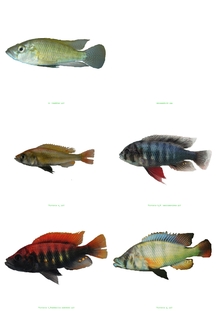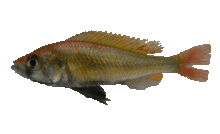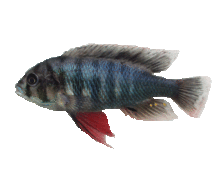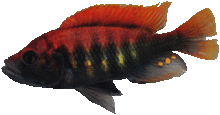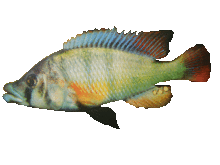News Detail
A new understanding of evolution
September 4, 2014 |
For this study, 27 research institutions around the world joined forces to investigate the history of the genomes of cichlid species from five distinct lineages with different propensities for diversification. “In their species richness, African cichlids are unique among vertebrates, with adaptations to a wide variety of ecological niches,” says fish and evolutionary biologist Ole Seehausen of Eawag and Bern University, who led the interdisciplinary project alongside Kerstin Lindblad-Toh and Federica Di Palma of the Broad Institute, and Todd Streelman of the Georgia Institute of Technology. To understand the molecular basis of this diversity of form and function, the scientists sequenced and analysed the cichlid species’ genomes.
Model for vertebrate evolution
Kerstin Lindblad-Toh explains: “Our study reveals a spectrum of methods that nature uses to allow organisms to adapt to different environments. These mechanisms are likely to be also at work in humans and other vertebrates, and by focusing on the remarkably diverse cichlid fishes, we were able to study this process on a broad scale for the first time.”
Value of random variations
In the Great Lakes of East Africa, more than 1500 cichlid species arose over a period of a few million years – and the 500 species in Lake Victoria took just 15,000 years to emerge. According to evolutionary biologist Catherine Wagner of Eawag and Bern University, who played a key role in the genome analysis, “This is the most rapid speciation process seen in vertebrates to date.” While the development of, for example, whitefish species in prealpine lakes during the postglacial period was similarly rapid, the total number of species that arose is much smaller.
But what genetic mechanisms allowed multiple cichlid species to develop within a limited area in a relatively short time, in a process known as adaptive radiation? Ole Seehausen believes that different types of random genetic mutations were amassed under low selection pressure in the ancestors of the major radiations: “At that time, this variation was probably not of much use, but it became incredibly useful when the fish colonized the East African Lakes. Here, the diverse ecological niches suddenly provided opportunities for a wide variety of adaptations.”
Result of numerous changes
The amazing capacity of cichlids for adaptation and rapid speciation is attributable, not to one major change in the genome, but to many different molecular mechanisms. In contrast to less diverse families of fish, which only evolved into a small number of species over a period of millions of years, the genomes of Pundamilia nyererei (endemic to Lake Victoria) and other highly diverse cichlid lineages were found to be more likely to exhibit changes based on three different mechanisms – variations in individual base pairs, gene duplications and insertions of transposable elements (DNA sequences which can change their position within the genome and thus alter gene expression). All these changes can occur at different sites across the genome. However, there may be variation not only in protein-coding elements, but also in regulatory sequences which control how genetic information is read and expressed in physical forms and functions. This also applies to microRNAs – small molecules which are involved in genetic regulation during embryonic development.
New tools for basic research
For the comparison of the five cichlid species, the entire genome (DNA) was sequenced, and RNA from ten different tissues was also analysed. As Catherine Wagner notes, “Even five years ago, based on the small sections of DNA that we could study with the methods at our disposal, we couldn’t say much about the genetic differences between closely related species.” With the new tools available today, biologists are able to look far back in time and gain a better understanding of the genetic basis of diversity – not just in fish, but in all vertebrates. Accordingly, Federica Di Palma, now head of Vertebrate and Health Genomics at The Genome Analysis Centre in Norwich (UK), emphasizes the potential significance of these “natural mutants” for basic research in medicine.
Uniqueness of species formation
This study also demonstrates the importance of conserving biodiversity, as the interplay of various genetic processes at different times leads to the development of genomes with their own history and unique architecture. “If a species disappears, it is lost for ever,” says Ole Seehausen. At the same time, all neighbouring species lose part of their environment – and all related species lose a reservoir of genetic and regulatory variants on which they could draw, if required, through hybridization. The possible relevance of these findings for the emergence and disappearance of biodiversity in Switzerland is currently being explored by Eawag and Bern University – for example, in a study of the whitefish and char radiations in prealpine lakes.
The study was supported by the Swiss National Science Foundation, the National Human Genome Research Institute (NHGRI), the German Research Foundation (DFG), the A*STAR Biomedical Research Council (Singapore), the European Research Council and the Wellcome Trust.
The paper entitled “The genomic substrate for adaptive radiation in African cichlid fish” was published in the online edition of Nature on 3 September 2014: doi:10.1038/nature13726
This release was based on a summary prepared by The Genome Analysis Centre (TGAC) and adapted by Sibylle Hunziker and Andri Bryner.
Pictures
In Lake Victoria, the descendants of a single ancestral species of river cichlid – represented here by astatotilapia tweddlei (top left) – include the following four species:
(Photo: Ole Seehausen)

